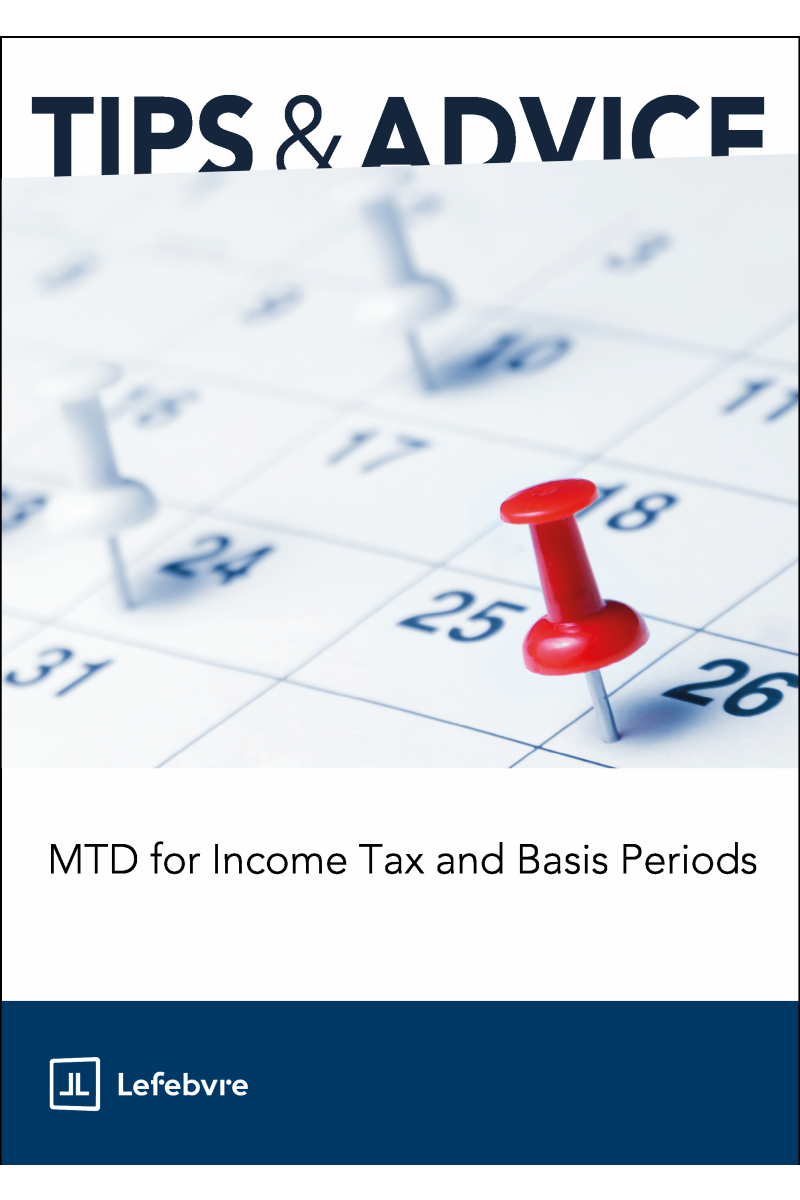MTD for Income Tax and Basis Periods
All the tricky issues explained

Time is running out to prepare for MTD for Income Tax (MTD IT). What’s more, basis period reform is far from over. Find out all you need to know about both with our Special Report “MTD for Income Tax and Basis Periods: All the tricky issues explained”.
If you’re a sole trader or landlord our Special Report explains what you can expect from MTD IT. It includes in-depth insights, practical strategies and easy-to-follow examples. It also considers potential problem areas, such as the new penalty regime, quarterly and end-of-year reporting requirements and interaction with cash and accruals accounting.
In Detail:
- Business impact - MTD IT applies to sole traders and partnerships with a turnover of £50,000 or more from April 2026 and most businesses by April 2028. Adapt seamlessly to new digital reporting requirements
- Joining MTD IT: Pros and cons of signing up to the pilot now or waiting until the deadline
- Record keeping: Meeting HMRC’s standard for the “digital journey”
- Reporting deadlines: What are they and what are the consequences of missing them?
- Tax liabilities: How income tax will be worked out under MTD IT
- Software: Make sure that your software is MTD IT compatible and what steps to take if it isn’t
- Accounting periods: How your choice of accounting period will affect your MTD ITSA reporting
- Basis period transition tool: Use this calculator to check tax efficiency for 2023/24 before the self-assessment amendment window closes in January 2026
- Profit spreading: Use the basis period transition tool to help you maximise tax efficiency and for transitional profit spreading. Make “what if” calculations quickly and easily
Buy your copy now and navigate the new digital tax landscape with confidence.
| Type of product | |
|---|---|
| Identifier (EAN / ISSN / Action Code) | 9781911744474 |
| Availability | In stock |
| Publisher | Lefebvre UK |
| Publication Date | Sep 30, 2025 |
Table of contents
1.2. Who does MTD IT apply to?
1.4. Quarterly submissions and end of year procedures
2.1. What’s the timetable for MTD?
2.2. Who will MTD IT apply to and when?
2.3. Where can I find the legislation and HMRC documents on MTD IT?
3.2. When will MTD IT apply to me?
3.3. How do MTD IT requirements differ from those for MTDfV?
3.4. How will MTD IT change self-assessment reporting?
3.5. What is the MTD IT routine?
3.6. Are there advantages to MTD IT?
3.8. What checks will HMRC make?
3.9. Avoiding trouble with HMRC
4.1. How are the mandation dates determined?
4.2. Who will be automatically exempt from using MTD IT?
4.3. Exemptions that can be applied for
4.4. Examples of when exemption might apply
4.5. What counts as MTD IT qualifying income?
4.6. My business started in 2025/26, when must I start using MTD IT?
4.7. How is income from abroad reported through MTD IT?
4.9. Is there a way to avoid or defer MTD IT?
4.10. How should I prepare for MTD IT?
4.12. Can I register for MTD IT before it becomes mandatory?
4.13. Will HMRC automatically include me in MTD IT?
5. Reporting requirements in detail
5.1. Quarterly submissions: what are they and how are they made?
5.2. How many submissions are required each quarter?
5.3. How accurate do the reports have to be?
5.4. What if I make a mistake?
5.5. What action will HMRC take after receiving a report from me?
5.6. How accurate will HMRC’s tax calculation be?
5.7. What’s the final declaration?
5.8. When do I make my final declaration?
6.1. What steps can I take to make MTD IT easier?
6.2. What periods will the quarterly submissions cover?
6.3. When must I file my quarterly reports?
6.4. What other deadlines are there?
6.5. Where can I find more information about deadlines and reporting?
7. Record-keeping requirements
7.1. What are the basic MTD IT record-keeping rules?
7.2. Should I use a bookkeeper or accountant?
7.3. What information must be recorded digitally?
7.4. Is any manual record keeping allowed?
7.5. How much bookkeeping do I need to do?
7.6. When must transactions be recorded digitally?
7.7. What are the requirements for MTD-compatible software?
7.8. How will my chosen accounting method affect my tax estimates?
7.9. Summary of accounting methods and MTD IT
7.10. What are the basic digital requirements?
7.11. Should I use cloud-based bookkeeping software?
7.12. Is digital record keeping sufficient for MTD IT?
7.13. What compatible software is currently available?
7.14. Are there special record-keeping solutions for cash accounting?
7.15. Can I use my own spreadsheet for MTD compatible record keeping?
7.16. How does a spreadsheet transfer the data to HMRC?
7.17. What non-tax issues should I consider?
7.18. Property rental businesses
7.19. What software should I consider if I use accruals accounting?
7.20. How soon should I start preparing my record keeping for MTD IT?
8. Calculating tax under MTD IT
8.1. Will I know how much tax I have to pay sooner?
8.2. When will I know what I owe?
8.3. Can I match quarterly estimates and annual bills?
8.4. How can I budget for tax?
9.1. What were tax basis periods?
9.2. What is the basis period reform?
9.3. How does the reform affect my business accounts?
9.4. How does the reform affect my property rental business?
9.5. Which tax years are affected by the reform?
9.6. What is overlap relief and transitional profit spreading?
9.7. How will profits be worked out after the transition year (2023/24)?
9.8. How do the changes affect other tax charges and reliefs?
9.9. How do I change my accounting year end?
9.10. When can I claim tax relief for transition losses?
10. Accounting - cash and accruals basis
10.1. What effect will the new cash basis accounting have?
10.2. How does cash accounting work?
10.3. How does accruals accounting work?
10.4. Which method will suit me?